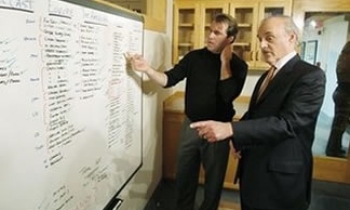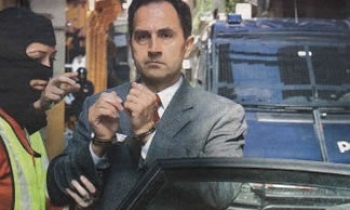NEW YORK: When The New York Times ran Kurt Eichenwald's Dec. 19 story about a 13-year-old who used his computer to sell sex acts over the Internet, the paper not only ran the piece on its Web site, it also included a Web-only essay and a video interview with the boy.
One month later on the opposite coast, Kevin Fagan of the San Francisco Chronicle served as a media witness at an execution, then recorded a podcast of his observations before he even began to write his story. "It was different than his written description, but compelling in its own way," comments Chronicle Editor Phil Bronstein. "Mixing and matching media has a certain impact of its own."
Although newspapers have been reporting via the Web for more than a decade, the extent to which online newspaper reports have expanded to include more video and audio elements, constant breaking news, and the exploding world of blogs, online columns, and reader feedback is nearly limitless. With podcasts, daily streaming reports, and other visual images, newspapers are combining their newsroom talent with the Web's immediacy and high-tech presentations to revolutionize news coverage well beyond the morning paper.
In the past year, numerous newspapers, including USA Today, the New York Times, The Sacramento Bee, and the Chicago Tribune, have reorganized their approach to create either 24-hour "continuous" news desks or combined Web/print newsrooms in which the online and print staffs are integrated. "The critical thing is that this is a merger, not a hostile takeover," declares USA Today Editor Ken Paulson. In a key move last December, he promoted Kinsey Wilson, who holds the top position at the paper's Web site, to an executive editor post. "It is a combining of talent," Paulson explains. "The hope is that the print edition will help enhance USA Today online, and those online will help bring their talent to the newspaper."
Charles Madigan, editor of continuous news at the Chicago Tribune -- which launched its 24-hour Web newsgathering effort in January -- says a never-ending news presentation is his paper's new primary focus. "We needed some vehicle to provide a constant stream of news to the Tribune Web site," he explains. "More timely, more aggressive, and staffed 24 hours." This is the "platform-agnostic" approach touted for some time by New York Times Publisher Arthur Sulzberger Jr.
But not every newspaper is jumping into this growing Web/print marriage with complete enthusiasm.
Although a growing number of reporters and editors welcome the ability to expand the print product and compete with their broadcast rivals for breaking news, others claim the expanded coverage translates into a staggering workload and excessive demands to feed the daily-news beast. Others contend that quality suffers when stories are rushed onto the Web too soon, or when reporters and editors are forced to complete distracting tasks like online chats before turning in a less-than-complete print version.
Newspapers have traveled a tough road toward Web/print integration, from the Los Angeles Times' Wikitorial debacle to consumer complaints about the New York Times requiring payment to read popular columnists online. The Washington Post, which produces one of the top newspaper Web sites, suffered recent stumbles when blogger Dan Froomkin got into a well-publicized dispute with print editors over the name of his blog -- and then a column by ombudsman Deborah Howell drew so many harsh e-mails that editors finally shut down a reader-feedback page. "When you are leading the way, you are always going to hit a few bumps," says Jim Brady, washingtonpost.com's executive editor. "It is a new world."
Then there are the ethical concerns about reporters engaging in blogs and chats, during which their reporting can stray into the quicksand of opinion -- leaving many writers wishing they had kept their mouths shut, and editors having to defend them.
In this issue of E&P, we examine the new Web initiatives that mark the arrival of the merged newsroom. Next month, in the second installment of this report, we will explore the fresh tensions, expanded workload, and new ethical issues surrounding the print/Web collusion -- which sometimes turns into collision.
Come together
When the Star Tribune of Minneapolis launched a redesign in October 2005, it provided columns that were easier to read, shorter Page One stories, and revamped lifestyle, entertainment, and weather pages. At the same time the paper also overhauled its Web site, added new search engines and additional reader blogs, and expanded its story resources.
But the biggest change was not what the print and Web pages were doing differently -- it was how they were more closely working together. The redesign launch was the set-up phase of what would become the Star-Tribune's new continuous news desk.
This strategy, in which the Web site is constantly updated with breaking news and all of the newspaper's resources are devoted to online, has been implemented in dozens of newsrooms in recent years. While the approach can differ from newspaper to newspaper, the general idea is still the same: The new deadline is from minute to minute, not the next day.
It creates a different conversation than there used to be," says Star Tribune Editor Anders Gyllenhaal. "We rarely hold stuff back from the Web now. There is more original content on the Web and leading readers between Web and print." In the Star-Tribune's case, presenting a continuous news desk meant reassigning 10 staffers from its online and print factions to work together each day in planning the best combined effort for more breaking news and Web-only content. "It makes us think both Web and print," Gyllenhaal adds.
The paper even employed this dual approach in announcing the changes, with an explanation in the print edition and an online video of editors discussing the paper's new focus and redesigns.
In noting the effect on news coverage, the editor cites the Star Tribune's reporting on last fall's murder trial of Chai Soua Vang, who was convicted of killing six hunters in neighboring Wisconsin. During the court proceedings, reporter Larry Oakes was filing multiple stories for the paper's Web site from the courthouse during the day, followed by print versions that "tended to be more forward-looking," Gyllenhaal says. He adds that the new approach includes a new issues blog by staffer Eric Black called "The Big Question" that includes discussions about stories of the day, "with a lot more in terms of original reporting around it."
As combined/continuous news operations emerge, each newspaper takes the formula in a slightly different direction. While some focus on simply getting breaking news up and explained quickly, others use the Web more to simply enhance the print story.
Still others opt to give both print and online equal weight in a truly combined presentation. "There are people whose world is primarily online or primarily in print," says USA Today's Paulson. "But that wall has to come down."
Although he is not adding staff to his 515-person editorial crew and has no plans yet for Web-only reporters, Paulson expects his site -- which hosts online chats on topics ranging from romance to football -- to add more such discussions and blogs: "It is about responding to news."
In Chicago, the Tribune's Charles Madigan put more than a year of planning into his paper's continuous news desk before it launched in January with nine full-timers. (Madigan was named to his new post in August, while staffers were trained in December.)
Just a year ago, he says, the site consisted largely of AP stories and newspaper articles posted the morning they appeared in print. But now, he says, "We are instantaneous on news. We don't have to wait to do anything." The paper also plans to unveil a new Web design focusing on the most up-to-date versions of stories rather than packaging the entire print content for Web.
One Tribune staffer most affected by the online push is police reporter David Heinzmann, who has been with the paper for six years and previously worked for the AP. He says the increased demand for content has required more midday stories as well as late-breaking Web articles, but says he understands the new approach: "I am called three or four times a week for stuff to get up right away. It is a little bit more work, but it is part of the game."
One example of this growing demand for instant news occurred in February 2005 when the husband and mother of United States District Judge Joan Lefkow were murdered, local killings that drew national attention because it appeared to be in retaliation for Lefkow's actions on the bench. Heinzmann says the first tip came in around 6:30 p.m. and Tribune reporters rushed to get the first story up, which they broke online by 9 p.m.
"It was an 'all hands on deck' story, and we ended up breaking it before the first news broadcasts," Heinzmann says of the scoop, and the long-term impact that such quick reactions are likely to have in the future. "Sometimes it is disconcerting because we have always looked at what we do as 'hitting-the-doorsteps.' Now our morning newspaper is not going to have the exclusives."
More output, more work
One of the most impactful Web/print combinations has taken place at the New York Times, which announced last summer the integration of its Web and print newsrooms -- which have operated separately for more than 10 years.
Physically speaking, the two staffs will remain a few blocks apart in different buildings until a long-delayed move to a new Times headquarters occurs in 2007. But combining these two resources gives Web producers and editors as much involvement in the daily news planning as those from print. "In the newsroom at 43rd Street, everyone should come to regard the Web site as his or her responsibility," Executive Editor Bill Keller stated in a memo announcing the merger in 2005. "By integrating the newsrooms we plan to diminish and eventually eliminate the difference between newspaper journalists and Web journalists."
According to New York Times Online Editor in Chief Leonard Apcar, one notable change is that he now reports to the newsroom's editors, not the corporate leadership. "Too often, the Web was late in the [assigning] process, if at all," he says of how the approach to using the two mediums has been altered. "Too many people are coming to the Times through the Web site to do that."
While the Web and print distinctions have not been eliminated, they continue to fade as the Times seeks to meld both forces as much as any major paper. Granted, the paper has not reached the Washington Post's level of blogging and online discussions. But the Times site made history in another way in 2005 with its first official regular blogging efforts, launching David Carr's "Red Carpet" page about the film awards season and "The Walk-Through," which focuses on real estate. "They are a way to publish small snippets of information," says Fiona Spruill, deputy editor of Times Online. "There are more ideas coming."
Apcar also notes that the site's use of video has doubled from an average of five to seven clips per week a year ago to 10 to 14 weekly now. Carr, technology columnist David Pogue, and travel writer Joe Sharkey have all become video bloggers. Pogue produced a memorable short on the uses of the smallest iPod, the Nano, during which he noted its potential use as a bookmark or tongue depressor.
For the moment, the paper appears to be devoting most of its online innovations to news presentation. In addition to the Eichenwald pornography story, numerous other print articles are routinely hitting the Web with expanded material. One example was the coverage of the January confirmation hearings for Justice Samuel Alito. A Jan. 10 story by David D. Kirkpatrick featured an interactive guide to Alito's past opinions, related editorials, and Supreme Court history, an online reporter's notebook by Kirkpatrick about the hearings, and a video report by two other Times reporters.
"There is no question the Web is a bigger part of our consciousness," says Jon Landman, the Times' deputy managing editor, who has been overseeing the combined newsroom. "The Web occupies a much larger chunk of our time and our work." Landman also has required each news section -- business, metro, travel, and others -- to designate a staffer to be its Web editor. But the newspaper has not completely pulled back from extensive print uses, choosing on Feb. 1 to publish President Bush's entire State of the Union address, which took up nearly two inside pages and could have easily been posted on the Web alone to save space.
Apcar acknowledges that reporting more on the Web translates into more work for staffers. "The biggest demand is managerial expectations, especially on their side," he says of the print editors. "We have to pick and choose. The scale of idea generation can rapidly outstrip our ability to do stuff." Landman adds that such concerns are valid, but also points to the way an early Web story can help enhance and improve the eventual print version by prompting sources to come forward.
One such case was staff writer Micheline Maynard's scoop in September 2005 that Delta and Northwest airlines were both planning to file for bankruptcy, which appeared on the Times' Web site at around 1 p.m. on Sept. 13. "I had never done that before, but I thought others would get it by 9 that night," Maynard recalls about the decision to break the story online.
"I ended up getting 11 phone calls from hedge-fund managers [that afternoon] and the pilots union put out a statement that it was going to meet the next day, all before anything happened." Northwest's stock, meanwhile, dropped by 50% between 1 p.m. and the market's close. When her print story hit the paper the next morning, it included virtually all of the reaction to the Web story.
Incidentally, Maynard's tip was right: The bankruptcies were filed.
Making the most of online
Its Wikitorial failure -- an experiment in open access to rewriting online editorials and posting messages that sparked profanity and near-vandalizing of the Web site -- has not stopped the Los Angeles Times from going all-out on the Web. Podcasts and video abound on its site, along with "The Envelope," the newspaper's award-show Web site devoted to everything Oscar, Emmy, and even Sundance. Hard news is not diminished, however, with the paper utilizing its online presence to enhance news stories in much the same way as its major market contemporaries.
For instance, a January series on the Los Angeles Unified School District's high school dropout problems went online with links to charts showing every high school's dropout rates, a database for readers to find their own school's information, more photos, a discussion board, and even an algebra test noted in the story that reportedly keeps many students from getting their diplomas.
Managing Editor Leo Wolinsky notes that his paper has moved slowly toward combining Web and print efforts for several years, beginning in 2004 when it created a seven-person "extended news desk," which rewrites stories throughout the day for the Web site, along with some Web-only content. Last year the paper appointed its first assistant managing editor/interactive, and is about to move the entire Web staff from its fifth-floor digs down to the third-floor newsroom.
"The goal is to put Web people on every news and feature desk," Wolinsky says. "There is a lot more to [news coverage] than the paper." He points to an online database the newspaper posted in late 2004 that included information on each priest in the paper's circulation area who had been charged with molestation. "That would not work in the newspaper, but it made sense to do it on the Web," he adds. In February, some newspapers that refused to print the Muhammad cartoons that caused rioting abroad, such as The Plain Dealer in Cleveland, provided links to them on their Web sites.
Just because The Roanoke (Va.) Times doesn't have the staff and resources of the Washington Post or Los Angeles Times doesn't mean it can't make creative use of the Web. And with its daily "TimesCast," the 98,687-daily circulation paper has shown a mix of local news, humor, and style you won't find nearly anywhere else.
"We try to make it as fun as possible," says Tad Dickens, scriptwriter and occasional on-air host for the 4- to 5-minute shows that post daily at 3:30 p.m. on the paper's site. "The intent was not to be TV news, but to be different." The single-camera reports have shown reporters in Caribbean outfits with palm trees, in empty white studios, and even with background images from a tavern. They mix local stories ranging from traffic problems to city government, as well as weather and the quirkier side of life. But these reports also include video, graphics, and photos.
"The idea was to sort of make it personality-driven," says Dickens, who is also an entertainment columnist. "Everyone is a distinct personality."
At the Naples (Fla.) Daily News (daily circulation 56,981), editors have been running a daily audio podcast each morning since October. Along with a wrap-up of top news stories, the podcast includes an interview with a Daily News reporter who promotes a front-page story. "We had some people at first who didn't quite see the value in it," says Editor Phil Lewis. Tim Aten, the paper's news editor who also writes scripts and hosts the podcasts, admits that it adds work, but in a useful way: "I think it is more of a strain on the local desk. They are more affected because they have to flag stories for the Page One promotion."
The Daily Journal of Kankakee, Ill. (daily circulation 28,280), also took an unusual route to the podcast news report, with advertising sales representative Larry LaCost pushing for the move that newsroom editors have since embraced. While members of the paper's 16-person reporting staff collect interviews on new digital recorders, LaCost produces the 15-to 20-minute podcasts that currently run three times a week, but will likely go daily. "The most exciting part is that it reaches younger readers," says Daily Journal Executive Editor Denise Renckens. "It is a way to think outside the print product."
Then there are newspapers, such as the San Francisco Chronicle and The Dallas Morning News, that have assigned staffers to focus almost solely on shooting video for the Web. One such person is Lee Powell, a six-year Morning News veteran who had previously covered city government in nearby Plano, Texas. But for the past six months, he has essentially roamed the area with digital video recorder in hand, shooting everything from Hispanic dancers at a local high school to grass fires. "When stuff happens, I am all over the place," says Powell, 30, who says most of his work has been for non-spot news events. "Reporters are coming to me with ideas more and more. But I am not a photographer."
In fact, Powell says he received almost no training when he first picked up the camera last year, although he has had past video editing experience at different broadcast outlets. "I've taught myself the basics of it," he says about his new device. "I always have it with me." The Web's near-limitless space also allows for lengthy reports, such as the five-minute documentary-style story he edited about the impact of increased development on a residential area near a reservoir. "TV would never do anything like that," he says. "We just let people talk."
Next month, Part II: E&P will look at how the new freedoms and opportunities presented by newspaper Web sites have also caused a new batch of headaches -- from work overload to newsroom resentment and tension -- and how newspapers are reacting to them.
Joe Strupp (jstrupp@editorandpublisher.com) is a senior editor at E&P.









